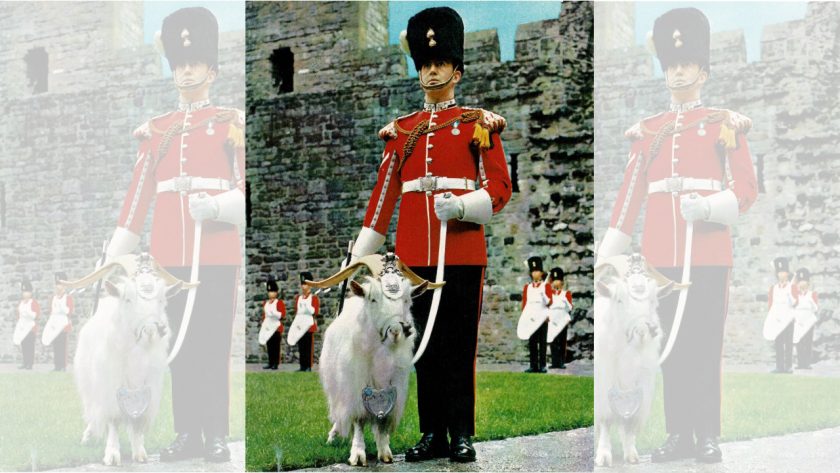Community Council announce plan for Royal Welch Fusilier memorial garden in front of Hightown Barracks

An new project is now under discussion by Offa Community Council to construct a memorial garden to the Royal Welch Fusiliers in front of the Hightown Barracks in Wrexham.
The project to erect a bronze lifesized sculpture of a Royal Welch Fusilier with the regimental goat in a flood lit landscaped setting is now gaining momentum. The sculptor chosen for the commission Nick Elphick of Llandudno has done many similar public commissions with his work exhibited all over the country and he is well known from his appearances on the SKY Discovery Channel.
Offa Community Council say they are working in partnership with representatives from the Royal Welch Fusiliers and other organisations including Wrexham County Borough Council and the Wales and West Housing Association on the project.
Already some local businesses have come forward on hearing of the project with offers of help; Stewart Rawson Electrical of Wrexham have offered to install the floodlighting around the sculpture for free, Bellis transport have offered to transport the finished sculpture to site from the foundry and Wales and West Housing Association have offered to install the footpaths, benches and noticeboard.
Several Community Councils in other parts of Wrexham have offered to contribute financially towards the project and Offa Community Council and the RWF are committed to large financial contributions towards the overall costs. A bid to the Heritage Lottery Fund for further funding is currently underway.
It is expected that some residents and businesses of the town will also like to get involved in some way and they are invited to contact the Clerk to Offa Community Council Mrs Karen Benfield at: [email protected] with all offers of help.
The Community Council say all contributors to the project will be publicly thanked in press releases and invited to the opening ceremony – and talks are currently underway with an International TV channel to make a documentary on the project.
The Community Council added that Offa Community Councillor David Jones had been researching the history of the regiment and its long association with Wrexham dating back over 300 years, and have sent Wrexham.com the below interesting write up:
Royal Welch Fusiliers – it originated on 16 March 1689 when Henry, 4th Lord Herbert of Chirbury, raised a volunteer regiment that was soon designated the 23rd Regiment of Foot. On 15 December 1702 they became The Welsh Regiment of Fusiliers ‐ a reference both to their recruitment area and their use of the then state‐of‐the‐art firearm, the fusil. As a reward for gallantry ‐ a trait so often exhibited by the RWF throughout its history ‐ George I conferred on them (9 November 1714) the title the ‘Prince of Wales’s Own Royal Regiment of Welsh Fuziliers’. Later in the century (1771) they were referred to as ‘The Royal Regiment of Welch Fusiliers’.
By that date the tradition of the Regimental Goat, was long‐established.
A full member of the regiment – not a mascot – he holds the official rank of Lance Corporal ‐ and is the responsibility of a junior NCO with the honorary title of Goat Major. Royal Goats were first presented by the monarch in 1844.
Another tradition is the use of ‘Welch’ in the regiment’s name. Whatever the evidence of the earliest official titles, ‘Welch’ was the preferred spelling as early as 1707 and was in common use until the 1850s. There followed a period when ‘Welsh’ became more prevalent giving rise to both spellings being used in different periods. The matter was only resolved in 1920 when permission was granted for the regiment to retain the old spelling – and it has been ‘Welch’ ever since.
The RWF’s association with Wrexham dates back to at least 1729 when a company was billeted in the town, and although a barracks was opened in Regent Street in 1857 for the Denbighshire Militia (it later became the police station and Magistrates’ Court and is now the County Museum and Archives), it was not until the Brigade Depots system was introduced in 1876 that work began on a new site for the RWF.
The new barracks cost £30,000 and housed two companies from each of the two battalions. They arrived on 17 August 1877 and were greeted by the Mayor, James Charles Owen of Alma House, Madeira Hill.
Wrexham has long been a place of recruitment for the RWF. This was especially true for The Great War when 40 battalions were raised. Sadly, almost 10,000 officers and men were lost in the ensuing conflict. One notable casualty was the poet Ellis Humphrey Evans (‘Hedd Wynn’).
Following the Second World War, the RWF received the Freedom of Wrexham on 15 June 1946, a privilege repeated at Wrexham on 17 September 1983 for the Borough of Wrexham Maelor. Another venue in Offa, the Drill Hall, Poyser Street, opened in 1902, had been home to the 4th Bn RWF until they moved to Hightown barracks on 9 October 1948.
The Depot system at Wrexham survived until 31 March 1960. The next day Wrexham was established as the Regimental Headquarters, a position it held until 10 September 1968 when the honour was transferred to Caernarfon, but the headquarters moved back to Wrexham on 1 December 1982.The current Colonel‐in‐Chief is Her Majesty The Queen, and to celebrate the 50th anniversary of this role , Her Majesty and the Duke of Edinburgh visited Hightown Barracks on 4 June 2003.
Without doubt, the RWF is one of the most remarkable and distinguished of any part of the armed forces. Some of the colours are on display in St Giles’ Parish Church which also has a dedicated Regimental Chapel. Many of the streets surrounding the barracks bear the names of those awarded the Victoria Cross. It has also been commemorated in a lively military march ‘The Royal Welch Fusiliers’ by American composer John Philip Sousa (1854‐1932) in memory of its work alongside the US Marine Corps in China (1900) and LMS Royal Scot class locomotive number 6118 was named ‘Royal Welch Fusilier’.As an independent corps the regiment existed for 317 years until 2006 when ‘rationalisation’ caused it to be merged with the Royal Welsh Regiment. When he reviewed the regiment in the summer of 1739, George II described it as ‘the finest Regiment He had seen’. Fortunately its name lives on as 1st Battalion The Royal Welsh (The Royal Welch Fusiliers). The Keep at the barracks is a Grade II listed building and the hope for the future is that the traditions of such a distinguished regiment will continue on this historic site.
Spotted something? Got a story? Email [email protected]













